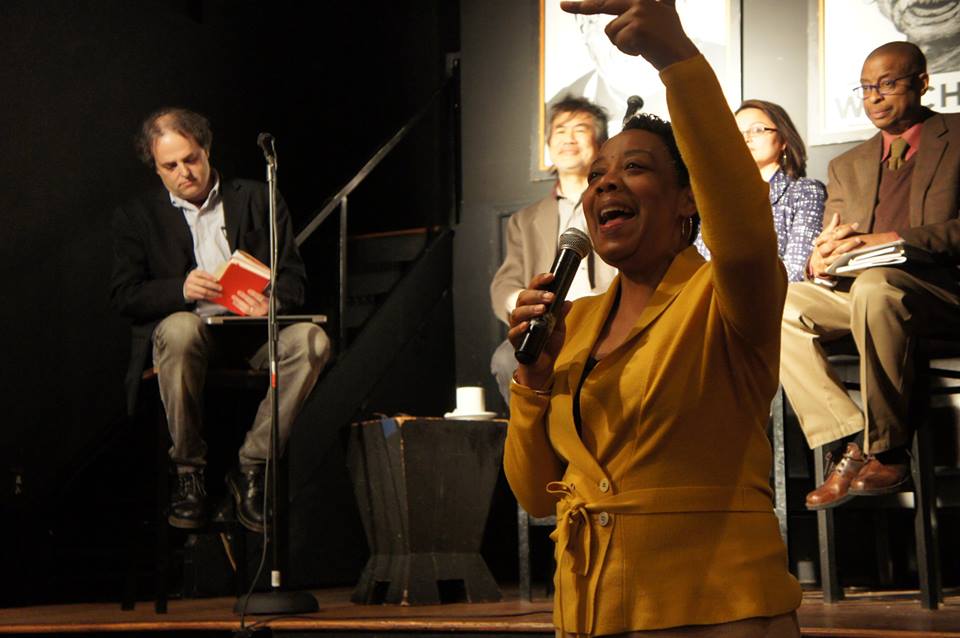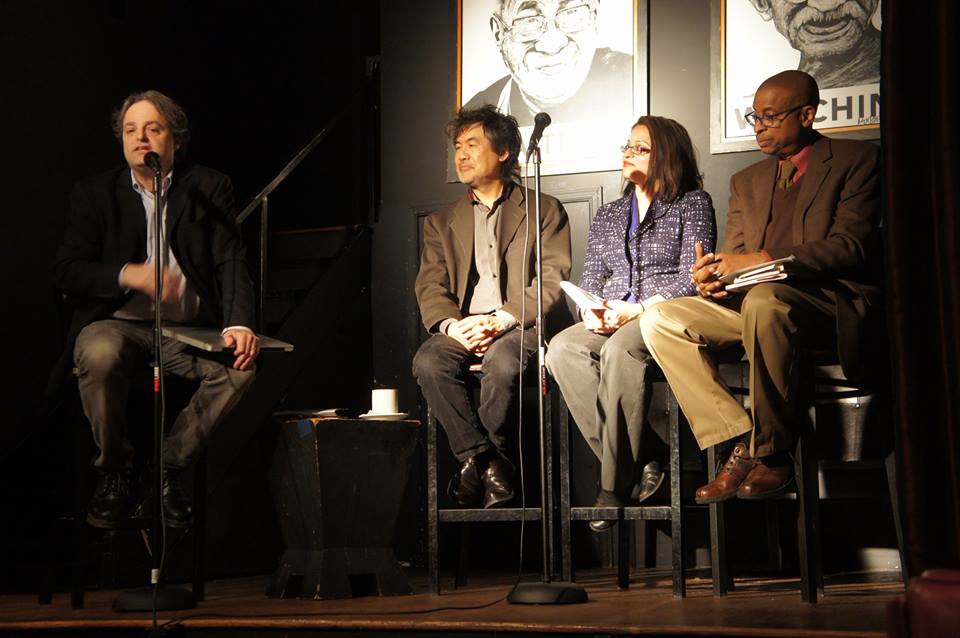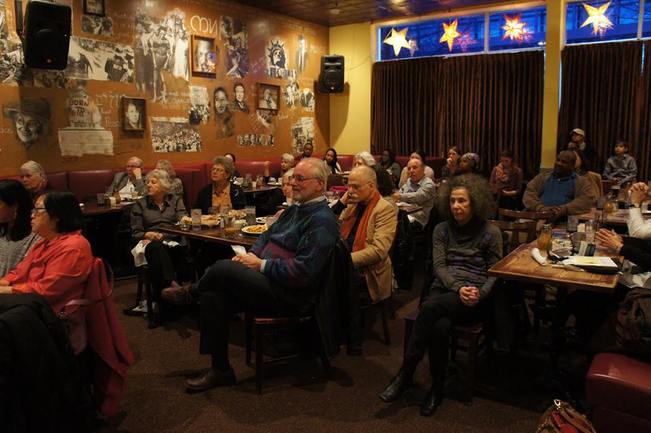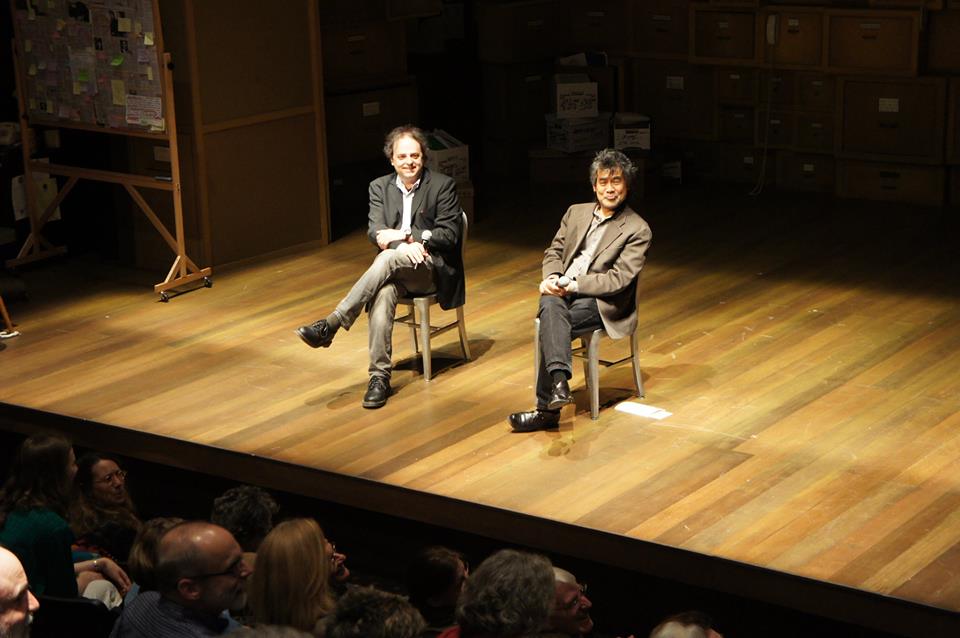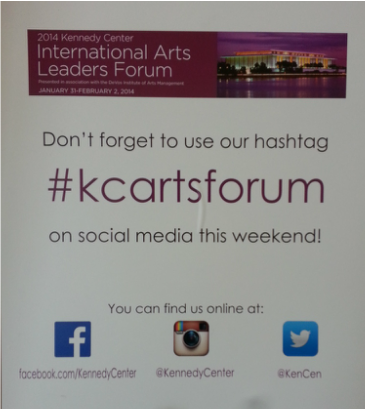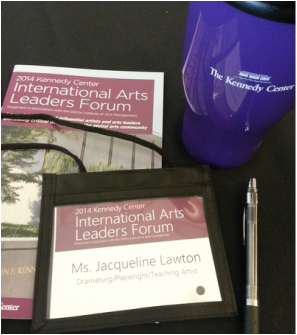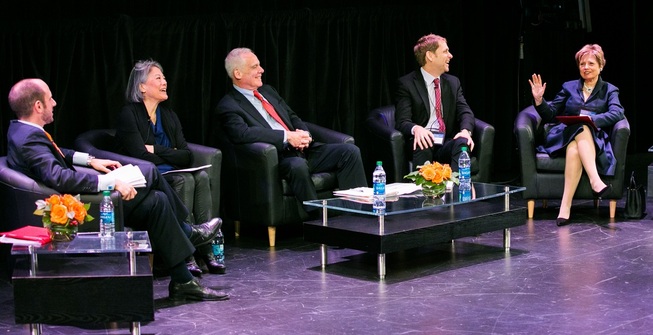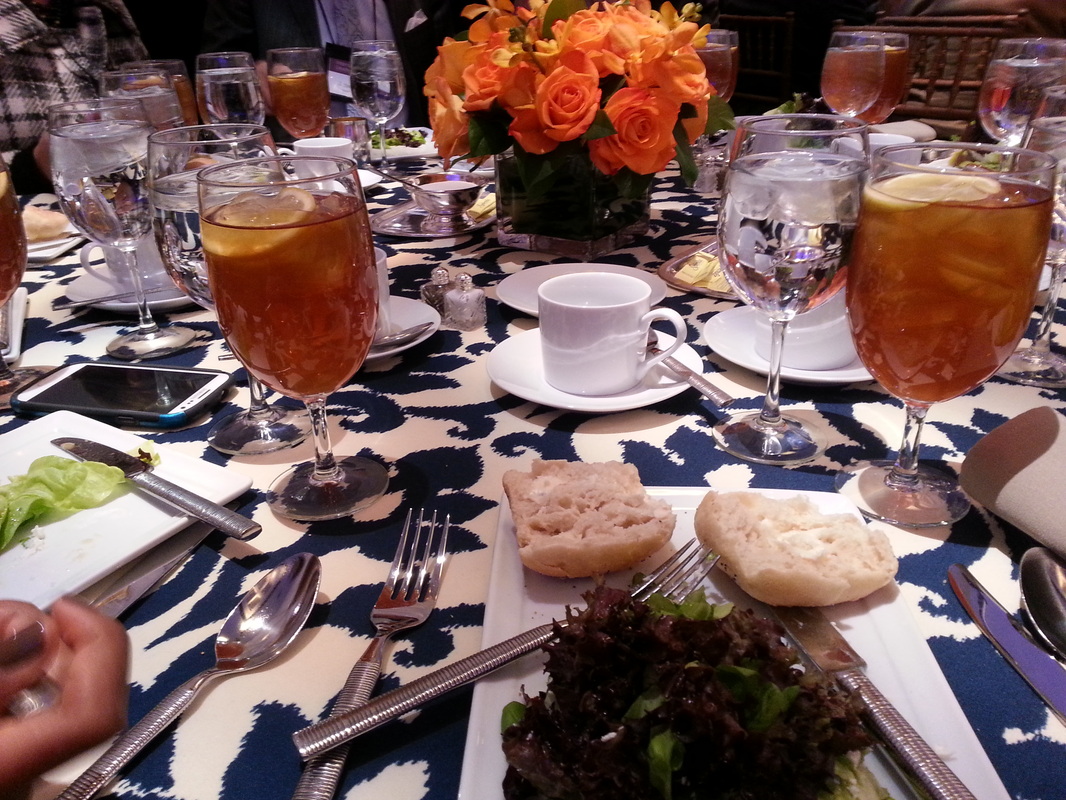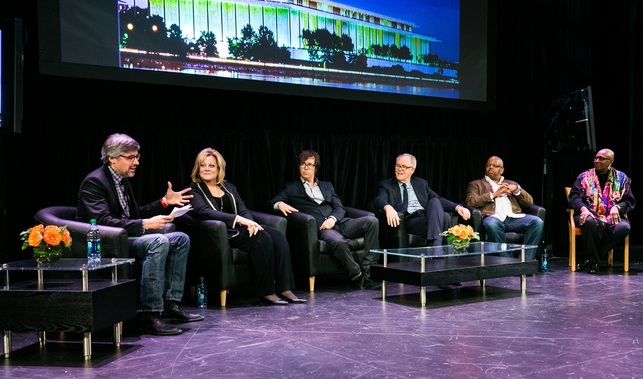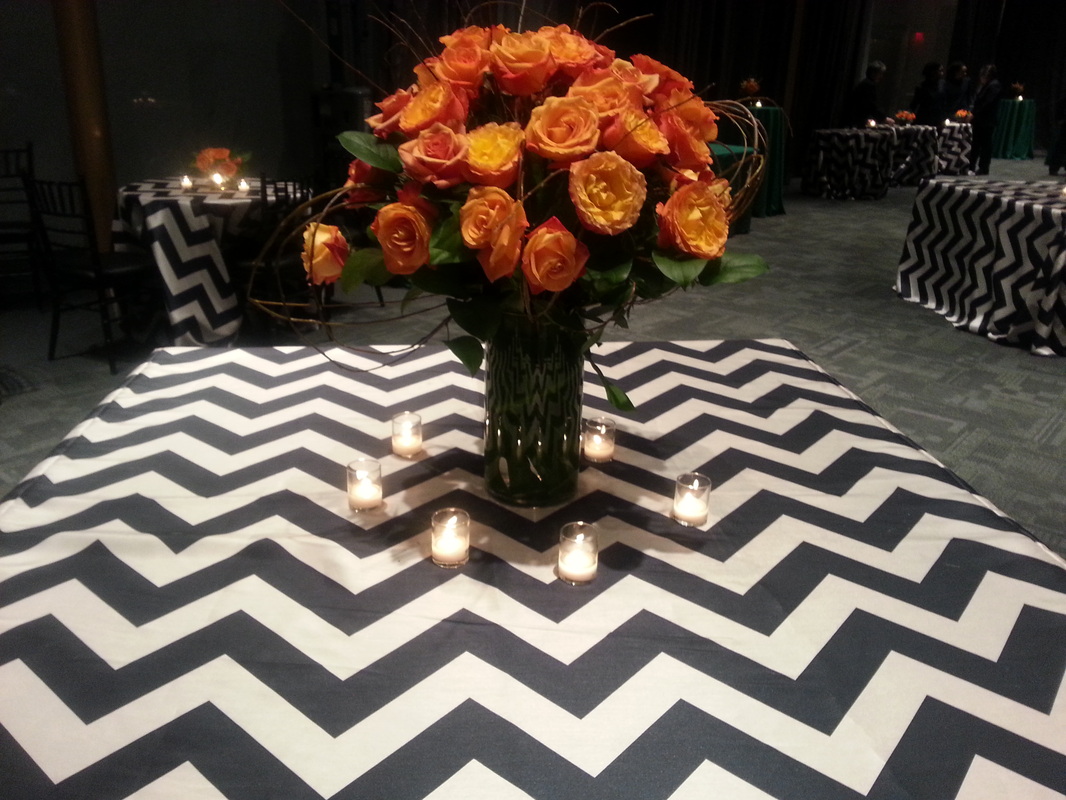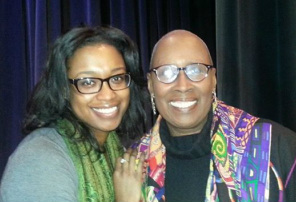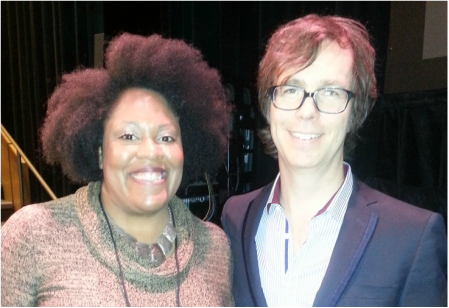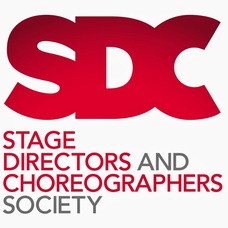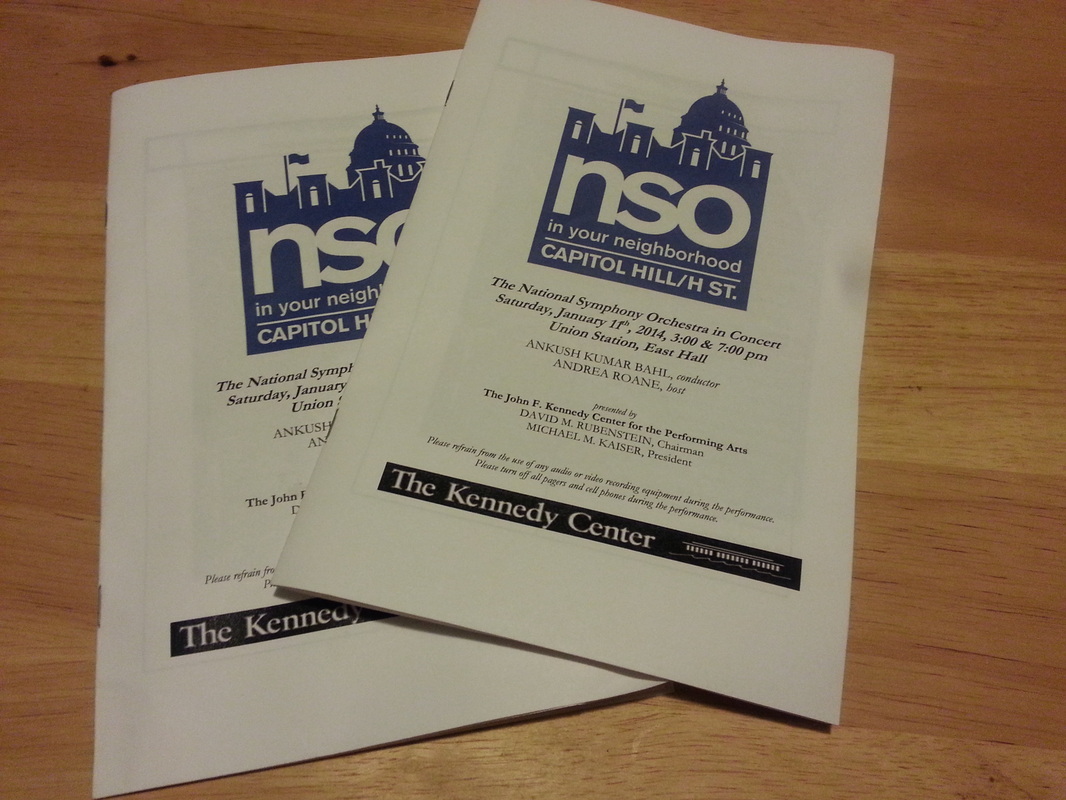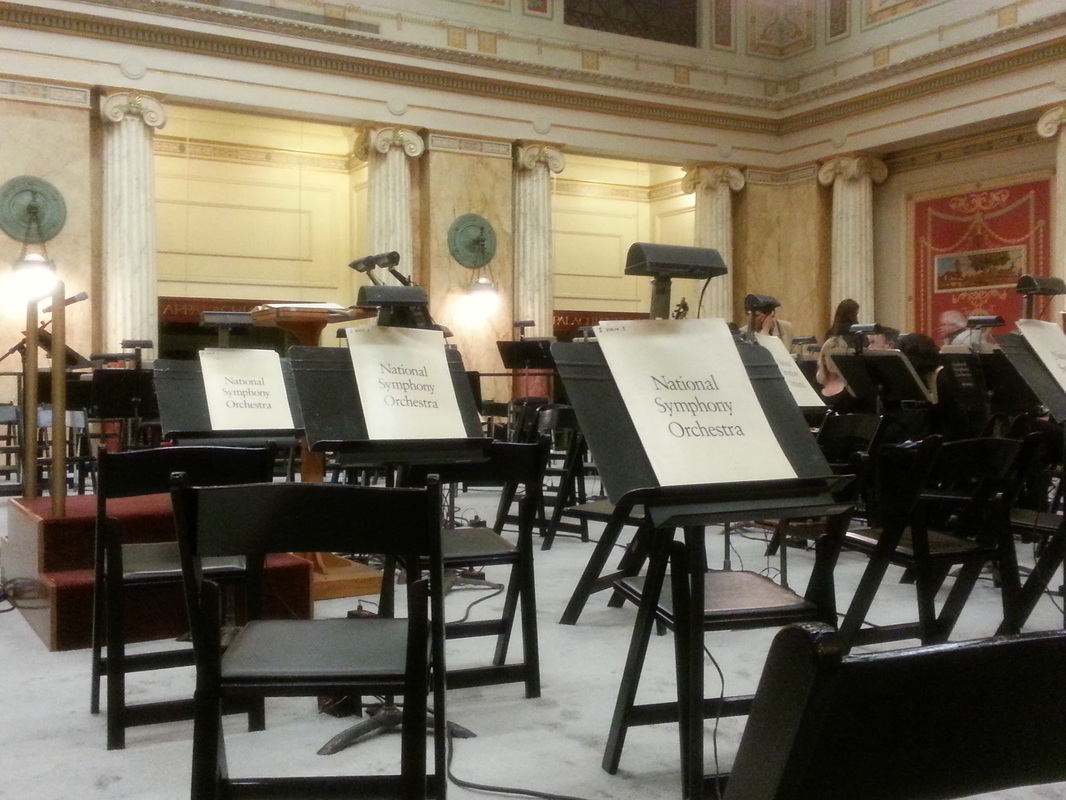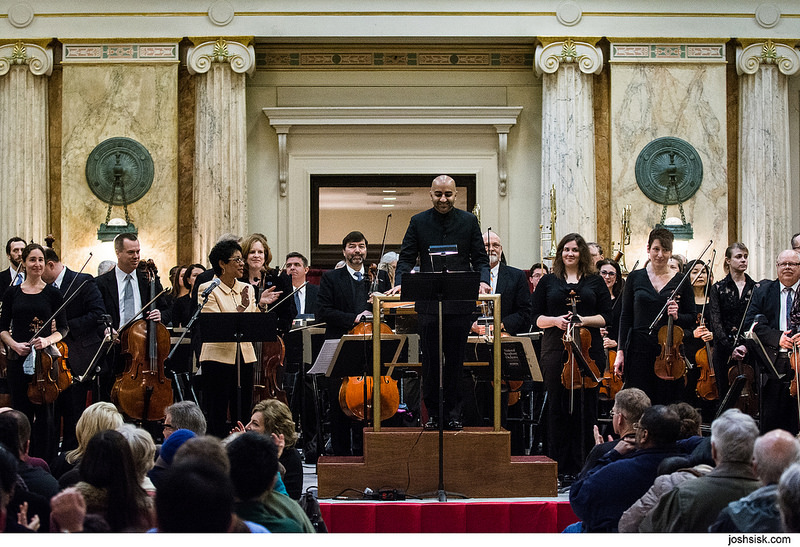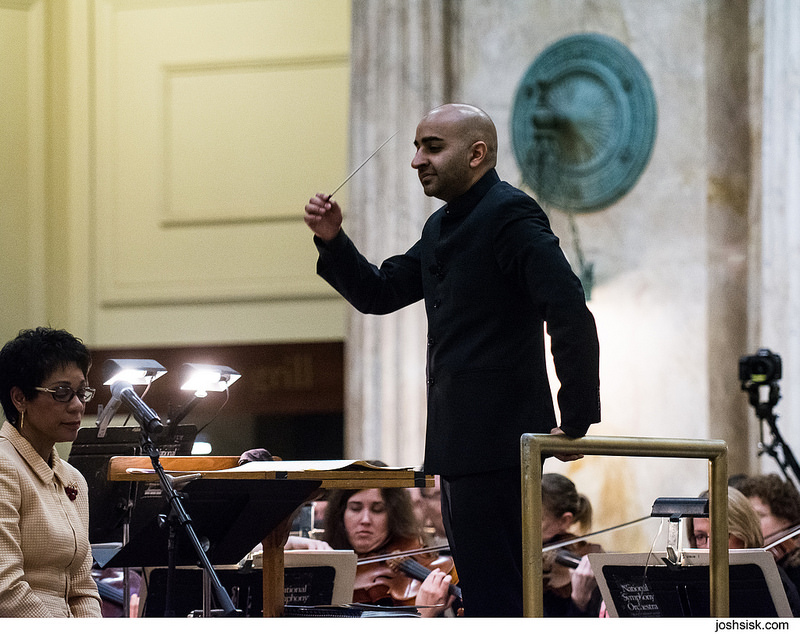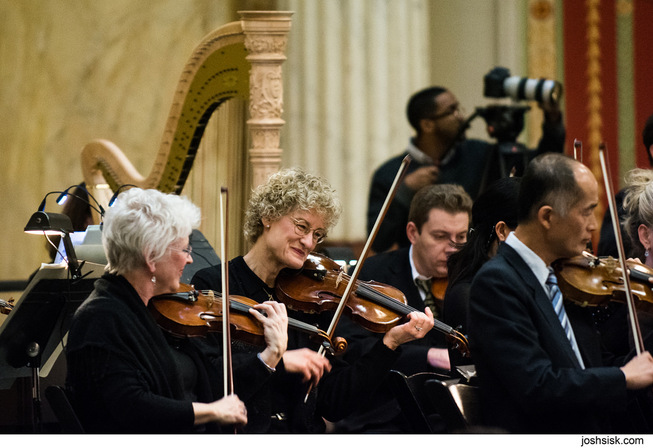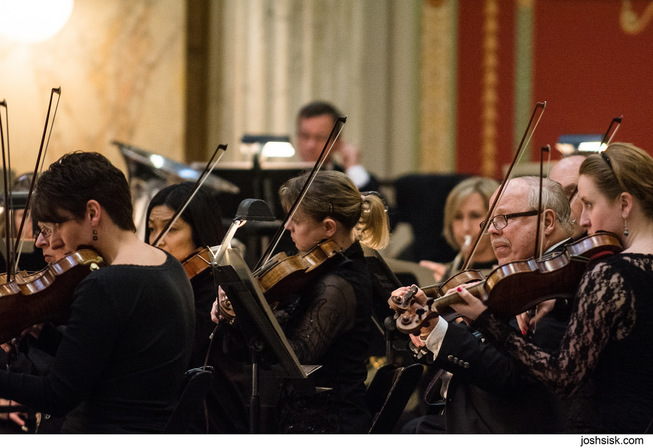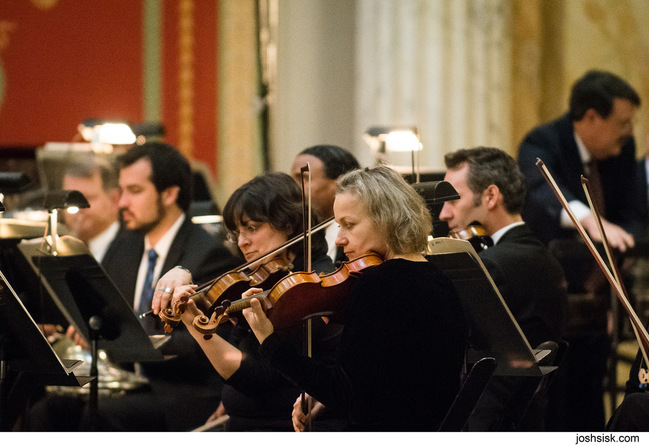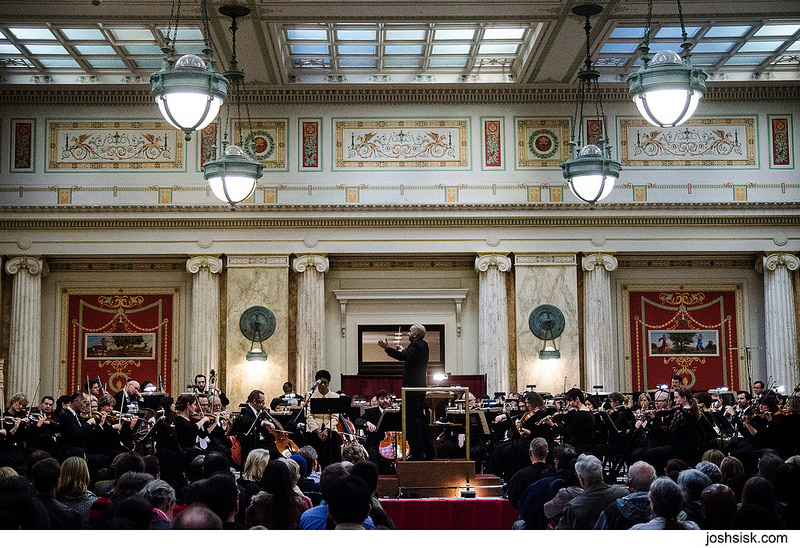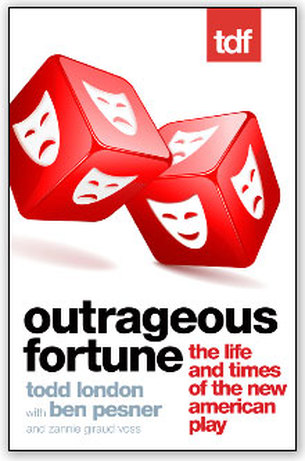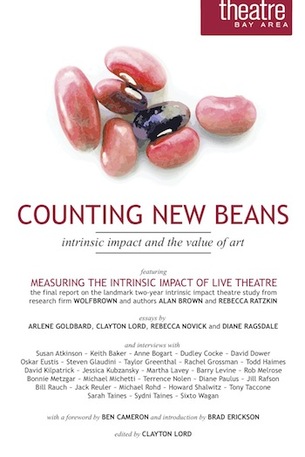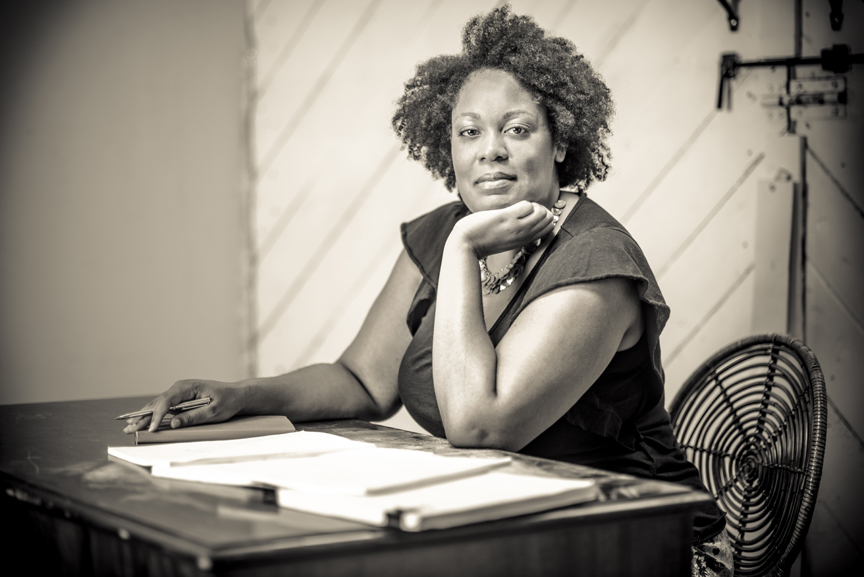A Special Edition of ACTOR: A Conversation with David Henry Hwang and Others about Race and Identity2/13/2014 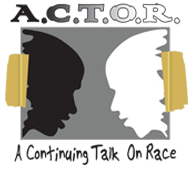 On Saturday, February 1st, Busboys and Poets presented A Special Edition of ACTOR (A Continuing Talk on Race): Conversation with Tony Award-winning playwright, David Henry Hwang about his new play, Yellow Face. Moderated by Theater J's Artistic Director, Ari Roth, additional panelists included E. Ethelbert Miller (poet, educator, and literary activist) and Deepa Iyer (Executive Director of SAALT: South Asian Americans Leading Together). The event was billed as a candid conversation about Race and Identity. 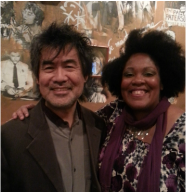 I arrived early for a late lunch with Theater J council member Elaine Reuben. The food is so great, but Busboys and Poets doesn't take reservations. So, I wanted to get good seats up front to take notes and a few photos. David was gracious enough to take a photo with me. I've long admired his work. M. Butterfly cracked open my world. Meeting him and getting to listen to him speak was an absolute highlight. Busboys and Poets Marketing and Events Director, Pamela Pinnock greeted each of us with a warm and rousing welcome. She told us that what made this event even more special was that it was taking place on Langston Hughes' birthday and on the 9th anniversary of Busboys and Poets. We began by paying homage to Hughes and his humble, but ambitious beginnings. While working as a busboy in Washington's Wardman Park Hotel, Hughes gave three of his poems to Vachel Lindsay, a famous critic. Lindsay was impressed by what he read and introduced Hughes to publishers and thereby launched the young poet’s career. Hughes would go on to be a noted writer of novels, short stories, poems and plays. Hughes traveled throughout his career and spent a great deal of time in both Japan and China. This got the attention of the U.S. Government, which was concerned about the communist activities of its citizens, and so Hughes was followed and spied upon during his travels. He captured his experience in two memoirs, The Big Sea and I Wonder as I Wander. Both are excellent, informative and entertaining reads. Ari Roth then introduced the panelists and the specific focus for the conversation. We were there to consider the role and responsibilities of an artist to his or her community. Part of that conversation included the joy and tensions that may arise when telling stories of one’s community. Given that February 1st marked the start of the Chinese New Year and Black History Month, there was a desire to have a Black and Asian cultural dialogue, and even address rising racial tensions. Where I see a competition for resources in the theatre community is around season planning. There is an unspoken, but blatantly practiced one slot rule in diversity planning so that either a play by a woman or a person of color will be presented. Theater J defies this rule as do a handful of theatres in the D.C. area. Ari’s first question invited the panelists to contextualize race relations in the Asian American communities from the 1990s to now: David shared that when he first started writing he had no particular sense of identity as an Asian American. The term “Oriental” was the terminology of the time. He started writing because he wanted to be a playwright. He felt that being Chinese was an interesting detail. He was a student of Sam Shepard and Marie Irene Fornes. He was guided to write from his subconscious and found that issues around immigration and identity began to emerge. When thinking about the relationship between the artist and the work, he feels that the artist invents the work, but the work also reinvents the artist. The work transformed him into the artist that he is today. He writes in a space of identity politics. Growing up, he felt that Asian Americans spent a great deal of time trying to be Americans. That they wanted to be American first versus the root culture that society framed on them. For him, Yellow Face is an opportunity to look back on what is now called multiculturalism. This is a comedy that allows us to laugh at it; to acknowledge the complexity and nuance of the Asian American identity; and to recognize the significance of a unified identity. Yellow Face also considers the ways in which the Asian American identity is useful and when it isn’t. Deepa shared that she was born in India and grew up in Kentucky before moving to D.C. She feels that the role of artists in the social justice movement is a critical one. Also, that the Asian American identity is more unified in a political context than it is in a cultural context. She reminded us that after 9/11, the South Asian community received a lot of backlash in terms of racial prejudice and religious bias. Many people associated South Asian with the Middle East, Islam and terrorism. She wants us to pay attention to power shift in the social and political dynamics as the U.S. becomes a minority majority demographically. We must also pay attention to relationships between people of color. She concluded by reiterating how much communities rely on artists to tell stories of their community. Otherwise, we risk silence, misinterpretation, exaggeration, and exoticism when our stories are told by others. Ethlebert spoke about Anu Yadav’s work. He referenced Meena’s Dream, which received a world premiere at Forum Theatre and is about to go on a national tour. In Anu’s own words, Meena’s Dream is about “a nine year-old girl whose mother is sick and can’t afford the medicine she needs. She has to face her fears, and use her imagination not just to cope or escape, but to bravely keep envisioning a world where all of us can have enough.” Ethelbert also spoke about Capers, an earlier one woman show based on interviews, interactions, and observation about the impact of gentrification/revitalization of an impoverished community. When I interviewed Anu, she spoke about the transformative power of writing and performance: “I was really inspired by performance artist Dan Kwong. I took an autobiographical performance writing workshop with him and Gary San Angel at Asian Arts Initiative in Philadelphia in 1999. It was only three weeks, during college. It was a tremendous experience. I had always loved theater, enjoyed it in whatever form it was available to me, but I also felt isolated or some sense of “I don’t belong here unless I translate myself” to the dominant culture. I didn’t see people who looked like me on stage, with the kinds of experiences that I connected to. That workshop was one of the first times that, rather than trying to fit into a role, I could shape the role by writing it myself, that my experience and my mind could lead in that way. It changed me. It was a hugely transformative experience to know that my experience as a human mattered enough to write down and share with an audience. I realized the power of sharing one’s story through theater as a political act. It helped me learn how to share more of myself in the world beyond the stage.” Ari asked David to speak about the role of humor and satire in their stories. David explained the premise for writing Yellow Face. He chose to write about himself because that way he was only making fun of himself. “If you’re going to having a conversation about race, you have to be willing to make a fool of yourself and make mistakes.” Ari then asked the panelist to speak to the solidarity and friction between artists of color. This was the most powerful moment in the conversation. The panelists addressed the fact that owing to our country’s history, we have to locate the space where we are internalizing racism against African American people in this country. As a society, the only way for us to build solidarity and heal is by dismantling stereotypes and perceptions. There will always be moments of harmony and tension, but we have to come together as communities of colors and work in solidarity to stand up against racist policy. David then spoke about living in Fort Greene in Brooklyn, a neighborhood that exemplifies gentrification. It was once considered very dangerous, but is now very hip part of Brooklyn. There is a diversity of races and careers, but there isn’t much class diversity. There are many tensions that still exist right now. How do we address income inequality. Ethelbert spoke about growing up in the Bronx. He grew up in a diverse area, but then moved into Saint Mary’s project. He went from an integrated school to an all Black school. His family was West Indian. He traveled from the South Bronx to Howard University. He didn’t have the black middle class/double consciousness angst. Also, his mother did not allow Ebony in his house. He then explained that we see the greatest growth and impact of diversity in our foods. He spoke about going to a baseball game. At first, it was just hot dogs, then hamburgers and pizza appeared. At some point, tacos showed up offered and now you can buy falafel and all kinds of healthy, organic, vegan food. This is diversity. Deepa spoke about living in Silver Spring. She’s noticed that there is a large Latino community, but it’s not as economically diverse. In Prince George’s county, there is an influx of refugees. This got her to think again about the role of artists. She grew up with people who had particular opinions or perceptions about her family based on the Simpsons and other television shows. Artists of color are still not given the opportunity to tell our stories. We have Katy Perry and How I Met Your Mother appropriating the Asian Culture for entertainment. But then we do have Mindy Kalin who has her own show. Still, the continued and persistent absence of stories by artists of color forces her to ask, “Is the white man’s truth bigger than ours?” At this point, Ari opened the conversation up to audience: An audience member asked: How do you feel the roles of words and language further or even hinder the discussion of race? David shared that one generations breakthroughs are often the next generations stereotypes. Stereotypes are bad writing. They are 1 and 2 dimensional characters that don’t appear human. Ethelbert reflected that as a poet, the power of his words exist all over the city and have traveled the world and even interpreted into other languages. He went on to speak about the importance of keeping the words of our great writers of alive. Too often, we reduce writers who have a large body of work to one poem or one novel. Or we don’t look at the full body of a writer’s life, and we hold on to one moment. This is dangerous and incomplete. He said, “Language is about communication and the ability to change our lives while we’re here.” This was a powerful and urgent moment. He went on to speak about how we should honor and uplift the work of our great writers. Simultaneously, we need to be taught about the criteria for what is good and the standard of excellence. Deepa shared that we are either trying to get people to include us (people of color) in the conversation about racial equity or we’re pushing back again words that being used against us. She went through a list of racially derogatory words that are used against Asian Americans and then asked “How do we change words that can denigrate people?” For instance, the term illegal immigrant is now no longer used in the press and has shifted to undocumented immigrant. (Click here to learn more.) We need more instances of this. She also explained two more terms:
The conversation then turned to color blind casting, which is the notion that we cast without regard to race. David shared that it comes down to an employment issue and an aesthetic issue. I agree with him that I like when minority roles are cast in nontraditional parts, but not the other way around. Either way, if you are going to cast nontraditionally, you need to be rigorous, clear and specific about the choices that you’re making. An audience member then asked: “Are we passing on issues of race from one generation to the next?” There was a shared response from the panelists that you have to look at how race is address in your own home, around your dinner table, and how it’s reflected in the people that are a part of your and your children’s lives. No matter what you teach at home, there is the impact of social movement happening around your child. You can only instill them with strong values and give them tools to achieve. Ultimately, society wants you to check a box. Furthermore, there is a continued desire to define us as post racial, but racial formation of this country is constantly in flux. Deepa strongly advised that it is incumbent upon us to push against this ideal of post racial society. It is a dangerous and omitting ideal. Ari shared that the Jewish community has an ambivalent relationship with assimilation. He felt “there is a sense of legitimacy to have ‘others’ play us on film and television. There is a sense of honor and recognition to be invited into other cultures.” After the discussion ended, I asked Ari to speak more about that, because I find it very interesting. In closing, Ari asked the panelists to share any final words of contemplation:
So much of this conversation reminded me of the dialogue that took place at Georgetown University's Department of Performance Arts symposium, Playing with the Past, (W)righting the Future, which explored how black playwrights and artists remember the past in order to imagine the future. It’s wonderful that so many of these conversations are taking place in the D.C. Theatre and Academic communities. My hope is that these conversations will lead to action that can be seen and felt in artistic programming and staff leadership. After the conversation, many of us headed over to Theater J to attend the final preview performance. The gorgeous photos above are production photos by C. Stanley Photography. After the performance David Henry Hwang joined Ari Roth in a post show discussion about the play. You can still see Yellow Face, which is playing at Theater J until February 23rd. Here's more information: 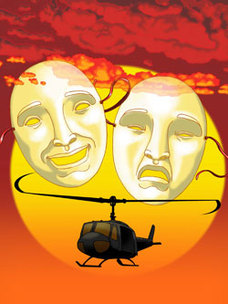 Theater J presents YELLOW FACE By David Henry Hwang Directed by Natsu Onoda Power Featuring Tonya Beckman, Mark Hairston, Stan Kang, Brandon McCoy,Sue Jin Song, Al Twanmo, Rafael Untalan, and Jacob Yeh January 29 - February 23, 2014 Click here to learn more and purchase tickets. About the play: The lines between truth and fiction blur with hilarious and moving results in David Henry Hwang's unreliable memoir. Fresh off his Tony Award win for M. Butterfly, Hwang leads a community protest against the casting of a famous white actor as the Eurasian pimp in the original Broadway production of Miss Saigon, condemning the practice as "yellowface." His position soon comes back to haunt him when he mistakes a Caucasian actor for mixed-race, and casts him in the lead Asian role of his own new play. When Hwang discovers the truth, he tries to conceal his blunder by passing the actor off as a "Siberian Jew." As Hwang struggles to ‘save face’ amidst family politics, international intrigue and government investigations, he explores timeless questions surrounding cultural identity, dual loyalty, and responsibility. A 2008 Pulitzer Prize finalist staged by the visionary director of Astro Boy and God of Comics. “A laugh-out-loud comedy, and an unexpectedly poignant odyssey of self-discovery" --New York Sun Running time: 2 hrs 10 minutes with 15 intermission 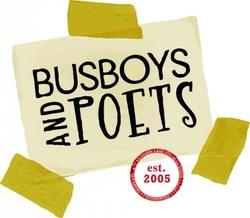 Busboys and Poets is a community gathering place. First established in 2005, Busboys and Poets was created by owner Anas "Andy" Shallal, an Iraqi-American artist, activist and restaurateur. After opening the flagship location at 14th and V Streets, NW (Washington, DC), the neighboring residents and the progressive community embraced Busboys, especially activists opposed to the Iraq War. Busboys and Poets is now located in four distinctive neighborhoods in the Washington Metropolitan area and is a community resource for artists, activists, writers, thinkers and dreamers. 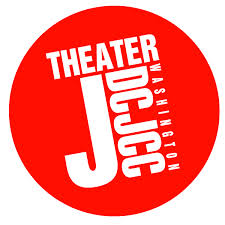 Theater J produces thought-provoking, publicly engaged, personal, passionate and entertaining plays and musicals that celebrate the distinctive urban voice and social vision that are part of the Jewish cultural legacy. Acclaimed as one of the nation’s premier playwrights’ theaters, Theater J presents daring contemporary work alongside spirited revivals and is a nurturing home for the development and production of new work by major writers and emerging artists exploring many of the pressing moral and political issues of our time. Dedicated above all to a pursuit of artistic excellence, Theater J takes its dialogues beyond the stage, offering an array of innovative public discussion forums and outreach programs which explore the theatrical, psychological and social elements of our art. We frequently partner with those of other faiths and communities, stressing the importance of interchange among a great variety of people wishing to take part in frank, humane conversations about conflict and culture.
0 Comments
On February 1 & 2, 2014 the Kennedy Center, in association with the DeVos Institute of Arts Management, presented the 2014 Kennedy Center International Arts Leaders Forum, an intensive weekend program for artists, arts managers, and board members to share ideas and discuss solutions to some of the big issues confronting the arts community today. The first in an annual series, the forum brings together some of the world's brightest minds from government, media, and the nonprofit world as keynote speakers and panelists for three symposia. "The performing arts are undergoing dramatic changes, and this summit will bring greater attention to the critical concerns of the artists, arts managers, and board members who must navigate these changes successfully.” —Michael M. Kaiser, Kennedy Center President and forum host Owing to a previous engagement, I was only able to attend Sunday's event. I took copious notes and have a few photos to share as well. Arts Managers Symposium Moderator: Brett Egan (Director, DeVos Institute of Arts Management) Panelists: Deborah Borda (President and Chief Executive Officer, Los Angeles Philharmonic), Howard Herring (President and Chief Executive Officer, New World Symphony), Patrick McIntyre (Executive Director, Sydney Theatre Company), and Chris Widdess (Managing Director, Penumbra Theatre ). This discussion focused on issues facing arts managers in the changing global arts environment. The panelists discussed ways to develop new sources of income, approaches to exploiting new technologies, and how to maintain artistic relevance and identity with the core audience while fostering and growing a robust base of younger audience members and donors. 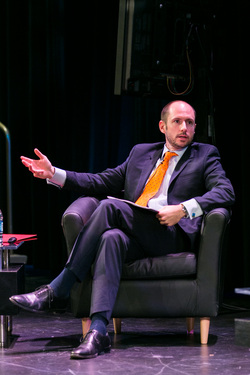 Brett Egan. Photo by Yassine El Mansouri. Brett Egan. Photo by Yassine El Mansouri. Moderator Brett Egan opened the discussion with an anecdote. He compared arts organizations to Modern Family, an American comedy series about a diverse, nontraditional family and used the Season One Season Finale episode, “Family Portrait" to explain the problems facing arts managers. In this episode, Claire’s elaborate plans for the perfect family portrait is spoiled by various mishaps. Eventually, she does get the entire family together and they are all dressed beautifully in white. However, her constant need for perfectionism gets on everyone’s nerves and a mud fight ensues. Claire is forced to let go of her perfect family portrait, and confesses later how much more she loves it As for how this situation mirrors the challenges faced by arts organization, Egan said that many arts organizations have a network of stakeholders (artists, audiences, and board members) who are committed to their organizations mission and vision, but are beleaguered, overworked. In addition to current duties and responsibilities, these folks must learn how to adapt to a radically diversified and ever changing community. In addition to this challenge, arts managers are trying to discover new ways for audiences to consume art and new venues in which to present art, while working to fill in the gap between what it costs to produce our work and the amount of revenue we’re able to bring in. Basically, we have a basic productivity challenge while audience participation is dropping. Click here to read the results of the latest survey from the National Endowment of the Arts (NEA). Egan then listed a breakdown of what he calls the Arts Manager’s Dilemma:
From there, the panelists spoke about their efforts to grow audiences. Here the questions that resonated with me:
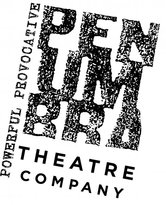 The entire conversation was informative, but I was particularly moved by Chris Widdess' brief, but powerful and informative presentation. She spoke candidly about recent challenges and successes at Penumbra Theatre. She also contextualize the impact of Black Theatre being created today. Here are some of the key issues she addressed:
I appreciated that this conversation addressed issues of diversity and inclusion as a way to grow audiences and better serve our ever-changing communities. However, I left feeling that our role of as artists as catalysts for social change and justice was undercut. While not surprising, because just as the arts are undervalued in our society so to is education. Still, I want to find ways to promote the work of artists as leaders and partners in civic engagement and social change. Luncheon Presentation 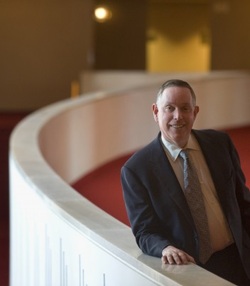 Michael Kaiser, Photo by Katherine Frey, Michael Kaiser, Photo by Katherine Frey, Julie Taymor was meant to be our keynote speaker, but she had strep throat and so was unable to attend. Michael Kaiser stepped into her place with a speech I'm told he gives quite a bit. It was my first time hearing it, so here's a snapshot of essential points: "Nations around the world are looking to the U.S. for models for how to sustain arts funding. Unfortunately, we don’t enjoy the support of large government funding. The Puritans who founded our nation believed music and dance were evil and that has led to a separation of art and state that has endured to this day. Organizations of color and rural organization face the greatest challenge when arts funding is cut. However, there is a great spirit of generosity in the American people. First, I am concerned about the quality of the art itself. I have observed that the creativity has been beaten out of so many artists and arts organizations. Everyone is so concerned about money and 'what sells' that we have gotten too conservative with our art-making. Producing boring art is the surest way to create fiscal problems because our audiences and donors look elsewhere. And, especially with so many online entertainment options available today, there are plenty of places to look. Too many organizations think they can remain healthy by producing safe art and too many arts organizations spend more time talking about money than about creativity. We don't just worry about money too much, we even talk about it too much. We must remember that our function is to inspire, entertain and educate our communities. We have spent so much time complaining about our plight and focusing on our financial challenges that many people do not want to interact with us anymore. They have come to us for respite but we have not been as accommodating as we need to be. We talk about money in the press, to our audiences, to our donors and especially to our board members. Our board meetings are almost entirely devoted to discussions of cash flow and income statements. We forget to discuss what we do for our communities, how much fun it is to come to an exhibition or performance, or how we educate our children to be creative thinkers. Then we are surprised that board members stay away and, worse, do not introduce us to their friends and associates. We must return our focus to our contributions to the community; few people really care about our problems. They have problems of their own! My second concern is that arts organizations simply are not doing a good enough job of marketing. We have a lot to learn from the sports world. Sports leagues do a great job of engaging people through their marketing activities. They don't just sell tickets, they encourage a relationship between the individual fan and the team as a whole. And these fans repay them by spending a great deal on tickets and souvenirs, food and parking. Too many people believe arts marketing is only about selling tickets. So their marketing efforts focus on advertisements, direct mail, email blasts, etc. These activities, which do help create earned income, I call programmatic marketing. Arts organizations have done a good job of creating programmatic campaigns though I observe that too many do not differentiate enough between the marketing needs of different types of programs. Most arts organizations have a template for marketing every project: they do three advertisements, a direct mail post card, a radio spot and two email blasts, for example. Others require a great deal more information, a new play by an unknown author, for example. These more challenging ventures need what I term missionary marketing – they require much more detailed explanations than can be accommodated by a poster or simple advertisement. We must save money on marketing the first type of program to invest in the second. And we must appreciate that online activities are our new best friends in creating visibility and educating audiences. We can reduce the amount we spend on programmatic marketing by using email, web sites, social networking sites, etc. to their full potential. People are getting their information in new ways - that is why newspapers are going bankrupt - and we must recognize it. But we must also invest in a second type of marketing, institutional marketing, that creates excitement for our organizations as a whole. My third concern relates to the ages of our audience members and donors. It is almost trite to say that our audiences are too old. In fact, that has been true for over a century! But we now face a different situation. American children were introduced to the arts by their parents but also in schools. I can remember a time when every child had a chance to sing in a chorus, perform a school play, play an instrument and learn to paint. Most children, although not all, stopped their arts participation when they hit high school and began thinking about dating, college, marriage, careers and families. Most people did not resume arts participation until middle age, when careers were underway, children were grown and they had more discretionary time and money. So while our audiences were older than the population in general, we had a constant replenishment of audience, donors, board members and volunteers. But today we have so little organized arts education in our schools that I am not so certain that as the current generation of school children ages, they will find their way to the arts if they didn't have them as a child. If not, who will be our audience members and donors of the future? In fact, I am far more concerned for the arts 20 years from now than I am about the current economic challenges we face. And while there is far too little arts education in our schools, even the education programs we do have are not substantial enough. They are disjointed, episodic and not very potent. That is because we leave the purchase decision for arts events to the individual teacher. If a third grade teacher loves the arts, the children in the class will get many arts experiences: they will visit a museum, produce a class play, learn from a teaching artist, etc. But when these same children get to fourth grade, they may have no arts if their teacher does not care about them. We do not teach any other subject that way. Imagine if your children or grandchildren came home and said they were not learning math this year because their teacher didn’t like it! My fourth major concern for the health of the arts relates to boards of arts organizations. Too many board members simply do not know enough about what creates health in the arts. While they approach their board duties with tremendous generosity of time, spirit and resources, they make decisions that are not necessarily in the best interests of their organizations. The most common mistakes include cutting art and marketing to balance the budget (when art and marketing are the very reasons people support us), believing that building an endowment will cure everything, suggesting that safe art is the easiest art to support and not forcing their executives to plan art early enough to help attract new donors. We need board members who know how to perform the five key functions of boards: developing and approving plans, understanding and approving the budget, hiring, firing, compensating and motivating their direct reports, participating actively in gathering resources and serving as ambassadors in the community. Arts organizations have a life cycle and board composition must change as the organization matures. When an arts organization is founded, the board acts like quasi-staff. They may do the bookkeeping, do the marketing, even sew the costumes. But as the organization grows and matures, it hires staff to fill these functions and needs its board to be more active in raising funds. Arts boards that do the best job of evaluating and changing their own compositions are typically the healthiest ones in our nation. While boards require training, arts managers need it too. My last major concern is that arts managers simply do not have the training they need to deal with the range of challenges I have addressed today. And that takes us back where we began, to the DeVos Institute of Arts Management at the Kennedy Center. The Institute addresses my belief that the greatest problem facing the arts today is not a shortage of great composers, choreographers or playwrights, but rather a serious deficit in trained managers to employ and support these artists. Arts management is a very young field and too many arts managers and board members simply do not know how to build the levels of support needed to makes artists’ dreams come true. The field needs its sophisticated donors to encourage, and might I say force, our arts managers to learn how to plan for important art, well in advance, to pursue sophisticated aggressive marketing campaigns, to create meaningful arts education programs and to encourage board members to fulfill their responsibilities effectively. Without strong leadership, the arts will not be able to create the artistic and educational programming that is so vital for our communities. Without strong leadership, our arts organizations will not build the large, engaged families of audience members and donors we need to stay healthy. Without strong leadership, we will not build the future generations of arts lovers and arts leaders. And without strong leadership, our system of arts funding will not sustain the remarkable arts ecology this nation has created. We are so fortunate to have the freedoms we have to create art and arts institutions in the United States of America. But with this freedom comes the responsibility to do it well." Performing Artists Symposium Moderator: Mo Rocca (humorist, journalist and actor) Panelists: Terence Blanchard (jazz trumpeter, bandleader, composer, arranger, and film score composer), Ben Folds (singer-songwriter and record producer), Judith Jamison (dancer and choreographer, and Artistic Director of Alvin Ailey American Dance Theater), John Lithgow (actor, musician, and author), Deborah Voigt (operatic soprano). This conversation addressed issues affecting the careers of performing artists: pursuing artistic interests in the face of changing audience demands, building new audiences, embracing new technology, coping with changes at arts organizations, and building a meaningful career. First, I must stay that this was a lively, passionate, entertaining, and poignant conversation. It was the perfect way to end this symposium. However, going into it, I learned about the sudden and tragic passing of Phillip Seymour Hoffman. I was deeply saddened and in shock, so it took me a while to get back into the flow of the conversation. You'll see that my notes are a bit scattered, but I've done my best to capture what was shared. Moderator Mo Rocco opened the discussion by asking the panelists about their early exposure to the arts. In a number of different ways, each of the panelists were exposed to the arts by parents, teachers and friends. Rocco then asked whether their parents ever asked to do something they didn't want to do. This drew a lot of laughs from the audience. A few of the panelist begrudged these early responsibilities, but ultimately appreciated that they were taught discipline, focus, and respect for practice at such an early age. Rocco then asked the panelists to speak about saying "yes" versus "no." For many young and emerging artists, this is such an important question. There is a tendency to say yes a lot early on, because being asked is such a golden opportunity. Eventually, however, you'll need to start saying know when the work either doesn't move you forward in your career or doesn't speak to the kind of work that you want to do. Saying no is just as important as saying yes, because each decision will help you learn about your voice as an artist and define your craft. Here's what the panelists said: John: I was mostly saying “Please!” and said yes whenever he had the chance! But regardless, whatever choice you make, will be the wrong one. You just have to make the best of it and know that you’re going to be fine. Deborah: As I've gotten older, I've had to decided whether I want to invest the time and energy into a role that I might never play again in my life. Judith: Early on, I had guides, teachers, and mentors who said yes for me. In dance, you'll have people telling you yes, regardless of what you might have wanted to do. And you're grateful for them, because they can see the path of your career in a way that you can't. Terrence: I say no a lot. I have to ask myself, do I want to present this work to the world knowing this isn’t who I am. But you sometimes take a beating for it because folks don’t necessarily run to promote you. After working with Spike Lee on Malcolm X, I was offered 11 Black films. Only I didn’t want to pigeonholed into one thing and so turned a lot of work down that didn’t represent who I was. Ben: I said no a lot as first because I was defining who I was as an artist. I played the piano and so I had a to have a piano. It would have been easier to play the guitar, but that's not what I wanted to do. Eventually, I grew to a place of yes, because I was interested and open to hearing input. But I still don't share my work until it's ready. I have to be at a place where I'm ready to share it and ready to hear input. Rocco then asked the panelist if they would every appear in a commercial or allow their work to appear in a commercial. Sometimes the idea of doing commercial work can be seen as selling out. Here's what Deborah and Terrence said: Deborah: Yes! It shouldn't be a problem for an artist to offer their expertise in a commercial. Terrence: I don’t see a problem with endorsements. What better way to introduce audiences to different genres of art. It is incumbent upon us as artist that once we have these audiences that we education them. This led Rocco to ask the panelists ]how we talk about the impact of their work and also the intersection of multiple art forms. I thought this question was great because for as many artist who remain specialized, we have an ever growing number of interdisciplinary artists. Also, as we look to grow audiences, we need to find more ways to collaborate with each other across forms. Here's some of what was shared: Terrence: When I work with students, I talk to them about finding their own voice. When we start out, you want to be or sound like someone else. I wanted to be the next Miles Davis. But you can’t be that someone else. You have to be you. So you have to take your experience, have confidence in your value, and create the art you were put on this earth to do. You are trying to communicate to an audience. Ben: Also, you want to listen to your peers and respond to what is happening so that you in the conversation that is happening now. You don't want to be at a dinner party where everyone's been talking about the football game and once the conversations over, look up and ask if anyone saw the football game. You don't want to be that person. John: Also, you never know the value of the impact of your work. Years ago, I did Footloose. It was a not so important movie. We didn't know at the time what it was going to be. Later, when I was working on 30 Rock from the Sun and an actor came up to me-in tears-- and he told me that because of my part in that movie, he was the first of six siblings to go to his high school prom. That actor’s father was a Baptist preacher. You just never know what your impact is going to be.. Rocco then asked them about the impact of social media. He was curious about whether the constant feedback has a positive or detrimental impact on the work. Ben: You get the feedback from the live audience. Anyone who puts out music and art, you’re going to have people who are going to hate you. But it’s tricky if it changes what you do that can get tricky. Deborah: She judges her performance by the reaction she receives from the audience. Works hard not to read the reviews. The longer you’re in the business, the harsher the criticism will be If I read a review and think it’s wonderful, then you have to read the bad reviews too. She heard from young opera fans that they are frustrated that there is a lack of social media around the work. Judith: I'm not on Twitter. I live a fairly private life, but after this conversation ... I think I might get on Twitter just to see what it's all about. Rocco asked the panelist about fun versus easy. "If the work is fun, does that mean it's easy? Do these two ideas go hand and hand?" John: Actors are playing a part. There is a playful and engaging exchange that happens between audiences, but it’s hard work. Judith: I tell dancers to enjoy themselves as they are going on stage. Enjoy this while you’re doing it. It’s not going to last forever. Savor every single bite. You’ve worked hard to get here. You’ve work hard in rehearsal. Be ferocious in your delight of the experience. In that ferocity you have your release. John: But the hard part is when it’s not happening anything. Terrence: But you don’t show the sausage being made. We don’t show the audience how hard it is. If you’ve worked at your craft, then there is no greater feeling that feeling free on the stage. Rocco's final question for the panelist was about labels. Ben summed it up perfectly: It’s complicated. You don't want to simplify anything, but you want people to receive information about what you do, the kind of art you're creating, and also know what to expect about the experience. The label has to be effective. At this point, the conversation was open to the public. The loose structure brougt reality back in But I dipped back into the discussion to hear that an audience member asked the panelists to speak about how they negotiate fear. Terrence: Fear fuels me. It’s what I learn from and intrigues me the most. I don’t want to be in the same place. If you’re standing still, the world is changing all around you. Rocco then ended the panel discussion by quoting Ben Folds Five song, "Do It Anyway": "And if you're paralyzed by a voice in your head It's the standing still that should be scaring you instead Go on and Do it anyway Do it anyway" And with that the Kennedy Center's first ever International Arts Leader Forum came to a close and we were all invited to take part in a lovely closing reception. However, before we went in, I talked Dafina McMillan (Director of Communications and Conferences, TCG) into getting a photo with the legendary Judith Jamison and because I spent most of undergrad listening to my best friend, Andrea Burghart (now Hinojosa) go on and on about the brilliance of Ben Folds, I got a photo with him!
The leadership of the Dramatists Guild of America and the Stage Directors and Choreographers Society strongly encourages President Obama to nominate swiftly a new Chair of the National Endowment of the Arts. On January 17th, the U.S. Senate allocated $146 million dollars to the NEA for 2014. This sends a very positive message of commitment and support to the arts community, who had expected a significant reduction based on a proposal last fall in the House of Representatives to cut NEA funding by upwards of 49%. The Chair of the NEA has been a vacant position since December 2012. By appointing strong leadership to the NEA to not only oversee the best uses of this annual budget but to champion the arts, President Obama signals their value to our country and helps to ensure their future in American culture. Click here to sign the petition and please share with your friends, family and colleagues. 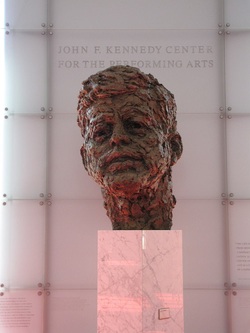 "If sometimes our great artists have been the most critical of our society, it is because their sensitivity and their concern for justice, which must motivate any true artist, makes him aware that our Nation falls short of its highest potential. I see little of more importance to the future of our country and our civilization than full recognition of the place of the artist. I look forward to a great future for America, a future in which our country will match its military strength with our moral restraint, its wealth with our wisdom, its power with our purpose. I look forward to an America which will not be afraid of grace and beauty." President John F. Kennedy, At Amherst College, October 26, 1963 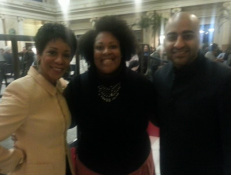 Last month, the National Symphony Orchestra presented NSO at UNION STATION, two train-themed" concerts at Union Station as part of their In Your Neighborhood Program. Under the leadership of NSO's Assistant Conductor Ankush Kumar Bahl, WUSA Channel 9's Andrea Roane served as mistress of ceremonies. I wrote the script, which consisted of short vignettes that not only introduced each song and composer, but also captured the spirit of the music and offered a glimpse of the vibrant landscapes one might see while riding a train. It was such a rich and joyous writing experience. I sat front row at both concerts. Applause and cheers abound after each song. Every now and again, I'd look around to see a room brimming with people of all ages, races and multiple abilities. I was delighted to see so many families with children. I can't say enough how much I enjoyed working with the National Symphony Orchestra and hope that this is the first of many collaborations. And now, at long last, I have these wonderful photos by Josh Sisk to share with you. Please enjoy!
''It is not enough to demand insight and informative images of reality from the theater. Our theater must stimulate a desire for understanding, a delight in changing reality. ...Theater must teach all the pleasures and joys of discovery, all the feelings of triumph associated with liberation.'' ~~Bertolt Brecht 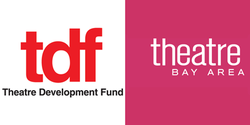 Yesterday, Theatre Development Fund (TDF) and Theatre Bay Area (TBA) hosted the first for six roundtable discussions intended to uncover the best new thinking and practices around what most effectively links audiences, generative artists and the theatres who produce them. Led by Victoria Bailey (Executive Director, TDF) and Brad Erickson (Executive Director, TBA), the meeting took place at Woolly Mammoth Theatre Company's Rehearsal Hall. Here's information about the project: Theatre makers around the country are experimenting with new ways to connect audiences with generative artists and their work. Through their project, Triple Play—funded by the Doris Duke Charitable Foundation—TDF and TBA are examining all sides of this crucial triangular relationship. They have surveyed playwrights, theatre leaders and audiences and will share their findings at these live and guaranteed lively conversations in each of six cities. They are inviting theatre companies, large and small, artistic and marketing leadership, playwrights, funders and committed audience members to share what's working to excite interest in new work. The project evolved from Outrageous Fortune, The Life and Times of the New American Play, commissioned by TDF, and Counting New Beans, Intrinsic Impact and the Value of Art. As leaders of service organizations committed to building theatre audiences, they believe that conversation between artists, theatre leaders, and audiences about how to approach, market, and advocate for new work is essential to this effort. With that in mind, Triple Play operating in three phases:
Yesterday's conversation happened in two-parts. The morning session was smaller than the afternoon, but both groups had representatives from Baltimore and D.C. area large, mid-sized, and small theatres, with different specialties (i.e., generative, theatre for young people, culturally specific) as well as playwrights of varying career stages and various theatre administrators. While the morning session was off the record, four audience members reported out our discussion for the afternoon session, which HowlRound live streamed. You can watch and listen here: Watch live streaming video from newplay at livestream.com I had the extraordinary privilege and responsibility of being in the room for both meetings. While honoring the closed door nature of our conversation, here are the questions, comments, and observations that stood out to me:
At one point, the playwrights were asked to share their thoughts on our relationship with audiences and arts leaders, and also why we wrote plays. In an attempt to respond to all that had been shared, here's what I said: "I attend theatre out of a deep curiosity to learn more about the world around me. With enough time, money, and the ability to get to the theatre, I'd see just about anything. When friends, colleagues, and students ask for play recommendations, I give them based on how well and how often a theatre presents a diverse range of artists and plays. As a playwright, I write out of a sense of urgency to give voice to members in our community whose stories have not been told. Of course, when a diversity of voices do not appear on our stages, is it any wonder that our audiences aren't growing?" For my part, I'd like to shift the language being used here and many others agreed. The context of the conversation was set around fear:
I don't want to talk about theatre in terms of risks just as I don't want to talk about diversity in terms of a challenge. I'd like us to speak in language of curiosity, discovery, and social change. Interestingly, during part of the afternoon conversation, I also participated in HowlRound's conversation around Race and Representation. The fact that these conversations were happening at the same time, but exclusive of one another resonated with me. As racial demographics continue to shift and knowing that minorities will be the majority in America by 2050, our theatre programming must shift to reflect these audiences. How to address diversity needs to be an intrinsic part of the conversation. There were several attempts to bring this into the conversation ... but it didn't quite seem to stick. When I left the meeting, I thought about Bertolt Brecht. Of course, I was en route to attend opening night of MOTHER COURAGE AND HER CHILDREN at Arena Stage, but also because Brecht understood the power and impact that theatre could have on a community. I think that if theatre artists want to remain relevant to audience, we need to start thinking about how our work if essential to survival and freedom. About Theatre Development Fund Theatre Development Fund, a not-for-profit organization, was created with the conviction that the live theatrical arts afford a unique expression of the human condition that must be sustained and nurtured. TDF’s twofold mission is to identify and provide support, including financial assistance, to theatrical works of artistic merit and to encourage and enable diverse audiences to attend live theatre and dance in all their venues. About Theatre Bay Area Theatre Bay Area’s mission is to unite, strengthen, promote and advance the theatre community in the San Francisco Bay Area, working on behalf of our conviction that the performing arts are an essential public good, critical to a healthy and truly democratic society, and invaluable as a source of personal enrichment and growth.  Each conversation will livestream on the global, commons-based, peer produced HowlRound TV network at howlround.tv. To participate in the online discussion use #trplplay @theatrebayarea and the local theatre’s handle. Click here to learn more. I was just reminded that my play, LIONS OF INDUSTRY, MOTHERS OF INVENTION, is now playing at the Smithsonian Associates' Discovery Theater. I first wrote it back in 2008 under the direction of Discovery Theatre's Artistic Director Roberta Gasbarre. What excited me about this play was that I had the opportunity to introduce Black Inventors to young children. Historically, the contributions made by people of color to fields of agriculture, science, medicine, beauty, and elsewhere are overlooked. This was a chance to correct that history and honor these extraordinary people. During one of our rehearsals, NPR's Allison Keyes stopped by to speak with me and the other artists about he play and our experience. Click here to listen to that interview and here's more information about the current production: 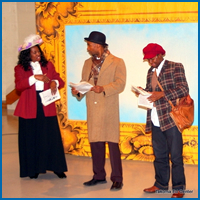 Lions of Industry, Mothers of Invention Tues.-Fri., Feb. 4-7 at 10:15 a.m. and 11:30 a.m. Ripley Center, Smithsonian Recommended for Ages 8+ Discovery Theater’s original interactive play honors the creativity and genius of African American entrepreneurs and inventors including beauty-product magnate Madame C.J. Walker; agricultural chemist and “peanut man” George Washington Carver; education giant Booker T. Washington; and George Crum, the cranky chef who accidentally created the potato chip. The production inspires the dreamer and achiever in all of us. Individual Tickets: Child: $6 ($10 on weekend) Child under 2: $3 Adult: $8 ($12 on weekend) Smithsonian Associate Members: $5 Group Tickets: Child: $5 Adult: $5 Click here to purchase tickets. If you have a group of 10 children or more, please visit our Group Sales page. Educational materials: Common Core Learning Standards Learning Guides |
My BlogI'm a playwright, dramaturg, and teaching artist. It is here where you'll find my queries and musings on life, theater and the world. My posts advocate for diversity, inclusion, and equity in the American Theatre and updates on my own work. Please enjoy!
Categories
All
Archives
June 2020
Reading List
|
